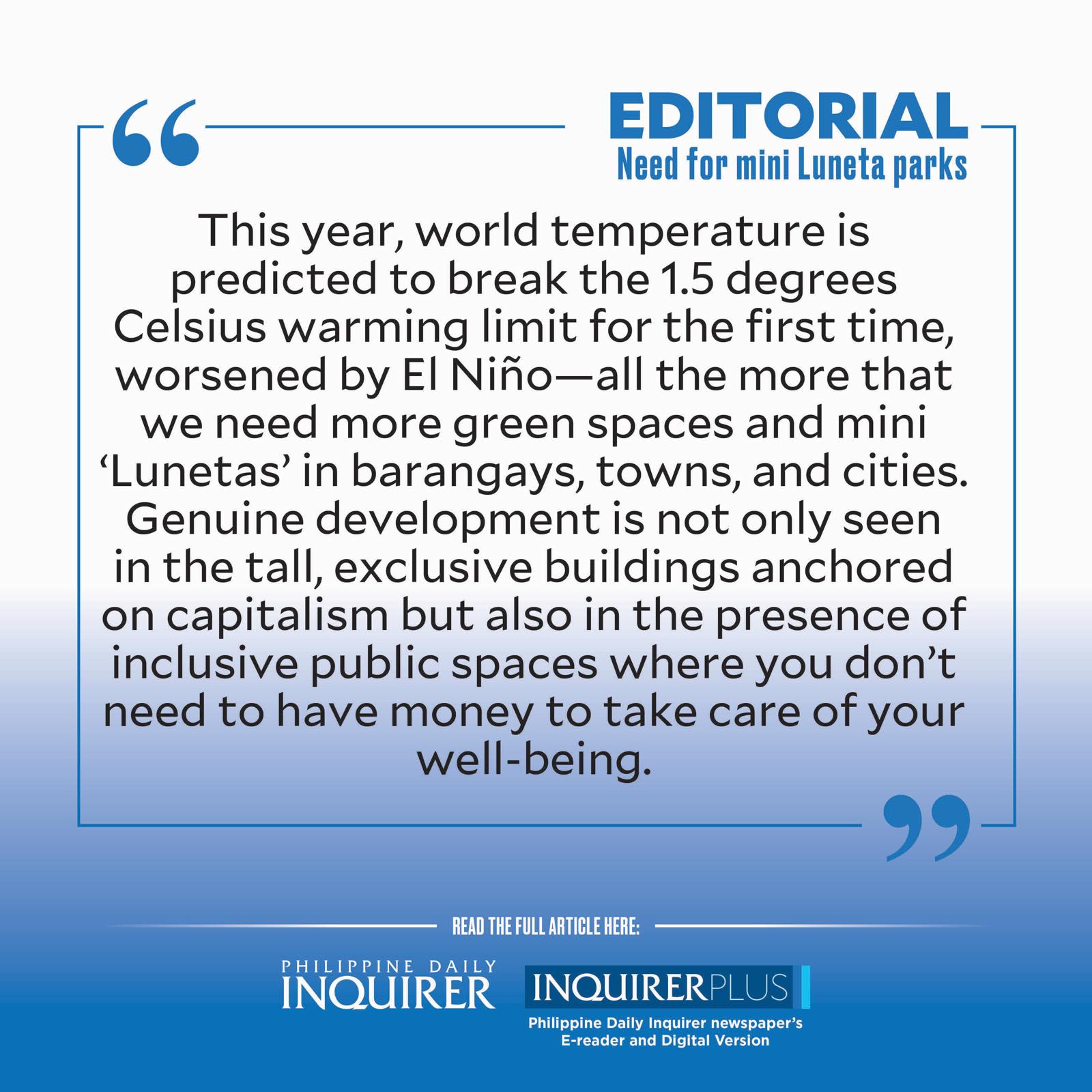Need for mini Luneta parks

Over the new year, the media published photos of crowds—families, groups of friends—strolling and enjoying themselves at the Rizal Park or Luneta, sparking nostalgia for that era when the nearby boulevard was still walkable and lined with trees, and no buildings marred the view in the historic park.
Families would spend weekends there and attend Sunday afternoon concerts at the Luneta Bandstand, where the Rizal Monument now stands, in the early 1900s. Even up to the late 1970s, the public continued to enjoy the park and it was even immortalized in popular culture through the 1976 OPM song “The Way We Were” with the lyrics: “Namamasyal sa Luneta, kahit walang pera.” These days such practice of enjoying weekends at a park has changed due to traffic and the lack of accessible open areas even in neighborhoods.
Article continues after this advertisementBut the crowds that flocked to Luneta this new year debunked the view that there is no park-going culture in the country. There can be—if only there are more accessible green spaces than malls, especially in Metro Manila. The mindset that development means construction of new buildings, roads, or bridges has instead prevailed in urban planning. How many parks and open spaces had to give way to buildings or parking lots? How many more trees would be felled for new roads?
Asia’s shopping capital
More than 150 malls dot Metro Manila’s skyline, per a 2017 article published by the Transnational Institute, an international research and advocacy body, earning the metropolis the title “Asia’s shopping capital.” This is an irony when there are 13.2 million families—half of the 26.4 million household population as of 2020—who consider themselves poor and can barely afford basic necessities, much more have the luxury of shopping at a mall. Many probably go to the mall instead to escape the scorching heat, especially during the summer months.
This only highlights the lack of green spaces in cities, where people can escape to and do recreational activities. Malls have become popular hangouts for the public because there is nowhere else to go, especially in places of high density. Based on research by the Green City Index, there is only an average of 5 square meters of open space per Filipino, quite a discrepancy from the 9 sqm per person recommended by the World Health Organization.
Article continues after this advertisement‘Green, Green, Green’ program“
The provision of public open space is an essential component of community life … Along with other community services and infrastructure, public open spaces are important public assets that contribute to livable, safe, and sustainable communities,” the Alliance for Safe, Sustainable, and Resilient Environments (Assure) led by urban planner Nathaniel von Einsiedel stated in “Public Parks and Open Spaces” guidebook meant to assist local communities, local government units, real estate developers, and planners. Assure went on to say that the Philippines is “severely deficient in the supply of public parks and open spaces which has not been given by government the kind of attention that it deserves.” This year, the government announced that it has earmarked P2 billion for its “Green, Green, Green” program meant to improve, rehabilitate, repair, and develop green open spaces including parks, arboretums, and botanical gardens but the result remains to be seen.
Assure further noted that while the Philippines has laws and regulations related to parks and public open spaces, they need more teeth to be fully implemented. To cite an example, the Department of Public Works and Highways issued October last year Memorandum Circular No. 68 providing for “guidelines on the creation, use, and management of parks and public open spaces for the promotion of physical and mental health and social well-being.” The memorandum noted that green spaces also serve as buffers that can help absorb global heating and as a ready venue for evacuation in case of natural or man-made emergencies. But it fell short of mandating the creation of these open spaces and, like many other memoranda in this country, is likely to be promptly forgotten.
1.5 degrees Celsius
On the other hand, it is also not just an issue of creating more open spaces for the public to enjoy, but to ensure that they are well-maintained. The crowds from Luneta’s new year festivities left a huge amount of trash including bottles, plastics, food waste, etc. that filled 60 trash bags. Unfortunately, many Filipinos still lack the discipline to dispose of garbage properly. We cannot demand such community service and infrastructure if we do not do our part in helping preserve and maintain them so that many others can enjoy them.
This year, world temperature is predicted to break the 1.5 degrees Celsius warming limit for the first time, worsened by El Niño—all the more that we need more green spaces and mini “Lunetas” in barangays, towns, and cities. Genuine development is not only seen in the tall, exclusive buildings anchored on capitalism but also in the presence of inclusive public spaces where you don’t need to have money to take care of your well-being.
















